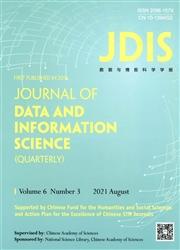创新的三重螺旋是国内外参与者的双重博弈
IF 1.5
3区 管理学
Q2 INFORMATION SCIENCE & LIBRARY SCIENCE
引用次数: 0
摘要
目的 创新行为者之间在地理层面上的合作关系可被视为国内和国外两个不同层面的组合。在每一层中,所涉及的关系和参与者构成了三重螺旋博弈。本文区分了三个层面的分析:全球层面包括所有参与者,国内层面包括国内参与者,国外层面仅涉及来自伙伴国的参与者。设计/方法/途径 本文利用博弈论分析了科学网(Web of Science)上关于韩国和西非的书目记录数据,按创新参与者进行了细分,并区分了国内和国际合作。在三个层面上计算核心、沙普利值和内核,以衡量参与者之间的协同作用。研究结果 韩国的协同作用大于西非;西非的政府作用大于韩国;韩国的国内行为体创造了更多协同作用,而西非的国外行为体创造了更多协同作用;韩国可以消耗掉所有的国外协同作用,而西非则不然。研究局限性 研究数据仅限于出版记录;所使用的技术和方法可扩展到其他研究成果。实际意义 西非各国政府应增加对科技创新的投资,以便从其创新参与者在国外贡献的协同作用中获得更多利益。然而,当前研究的结果可能不足以证明加大投资就能从国外协同效应中获益。原创性/价值 本文利用博弈论,通过计算外国参与者对地区层面知识生产的贡献来评估创新体系。为此,本文提出了一个指标。本文章由计算机程序翻译,如有差异,请以英文原文为准。
The Triple Helix of innovation as a double game involving domestic and foreign actors
Purpose The collaboration relationships between innovation actors at a geographic level may be considered as grouping two separate layers, the domestic and the foreign. At the level of each layer, the relationships and the actors involved constitute a Triple Helix game. The paper distinguished three levels of analysis: the global grouping together all actors, the domestic grouping together domestic actors, and the foreign related to only actors from partner countries. Design/methodology/approach Bibliographic records data from the Web of Science for South Korea and West Africa breakdown per innovation actors and distinguishing domestic and international collaboration are analyzed with game theory. The core, the Shapley value, and the nucleolus are computed at the three levels to measure the synergy between actors. Findings The synergy operates more in South Korea than in West Africa; the government is more present in West Africa than in South Korea; domestic actors create more synergy in South Korea, but foreign more in West Africa; South Korea can consume all the foreign synergy, which is not the case of West Africa. Research limitations Research data are limited to publication records; techniques and methods used may be extended to other research outputs. Practical implications West African governments should increase their investment in science, technology, and innovation to benefit more from the synergy their innovation actors contributed at the foreign level. However, the results of the current study may not be sufficient to prove that greater investment will yield benefits from foreign synergies. Originality/value This paper uses game theory to assess innovation systems by computing the contribution of foreign actors to knowledge production at an area level. It proposes an indicator to this end.
求助全文
通过发布文献求助,成功后即可免费获取论文全文。
去求助
来源期刊

Journal of Data and Information Science
INFORMATION SCIENCE & LIBRARY SCIENCE-
CiteScore
3.50
自引率
6.70%
发文量
495
期刊介绍:
JDIS devotes itself to the study and application of the theories, methods, techniques, services, infrastructural facilities using big data to support knowledge discovery for decision & policy making. The basic emphasis is big data-based, analytics centered, knowledge discovery driven, and decision making supporting. The special effort is on the knowledge discovery to detect and predict structures, trends, behaviors, relations, evolutions and disruptions in research, innovation, business, politics, security, media and communications, and social development, where the big data may include metadata or full content data, text or non-textural data, structured or non-structural data, domain specific or cross-domain data, and dynamic or interactive data.
The main areas of interest are:
(1) New theories, methods, and techniques of big data based data mining, knowledge discovery, and informatics, including but not limited to scientometrics, communication analysis, social network analysis, tech & industry analysis, competitive intelligence, knowledge mapping, evidence based policy analysis, and predictive analysis.
(2) New methods, architectures, and facilities to develop or improve knowledge infrastructure capable to support knowledge organization and sophisticated analytics, including but not limited to ontology construction, knowledge organization, semantic linked data, knowledge integration and fusion, semantic retrieval, domain specific knowledge infrastructure, and semantic sciences.
(3) New mechanisms, methods, and tools to embed knowledge analytics and knowledge discovery into actual operation, service, or managerial processes, including but not limited to knowledge assisted scientific discovery, data mining driven intelligent workflows in learning, communications, and management.
Specific topic areas may include:
Knowledge organization
Knowledge discovery and data mining
Knowledge integration and fusion
Semantic Web metrics
Scientometrics
Analytic and diagnostic informetrics
Competitive intelligence
Predictive analysis
Social network analysis and metrics
Semantic and interactively analytic retrieval
Evidence-based policy analysis
Intelligent knowledge production
Knowledge-driven workflow management and decision-making
Knowledge-driven collaboration and its management
Domain knowledge infrastructure with knowledge fusion and analytics
Development of data and information services
 求助内容:
求助内容: 应助结果提醒方式:
应助结果提醒方式:


